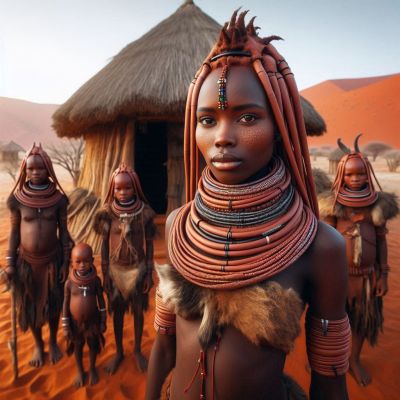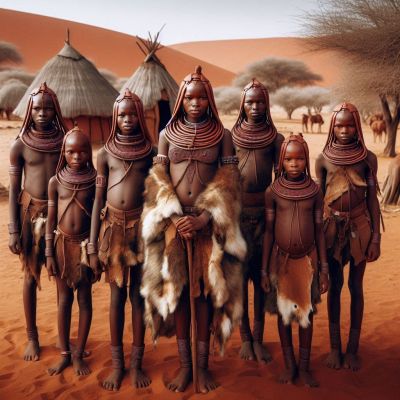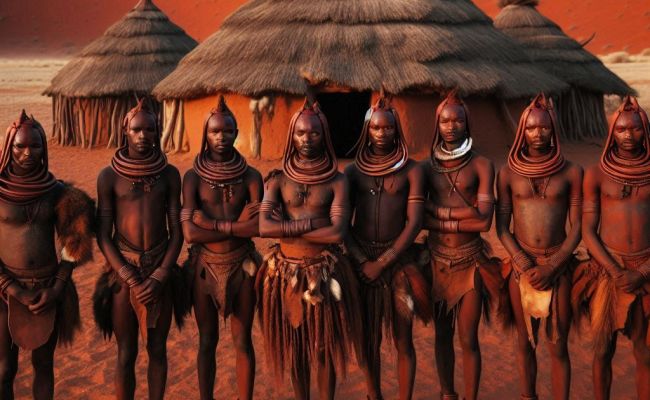The Himba people are an indigenous community who live in northern Namibia’s Kunene area and southern Angola. They live a semi-nomadic pastoralist lifestyle centered on cattle herding and are known for their unique cultural customs, which include traditional dress, elaborate hairstyles, and the use of otjize (butterfat and ochre).
This lifestyle is culturally and socially significant. Despite current pressures like climate change, land rights concerns, and the effects of urbanization, the Himba have maintained their distinct heritage and traditions, demonstrating persistence and adaptability.
History
The Himba people have faced several hardships throughout their history, including harsh droughts and guerilla warfare, particularly during Namibia’s fight for independence and the civil war in neighboring Angola.
Extreme environmental circumstances and political strife pushed the OvaHimba to the verge of cultural extinction in the 1980s. A terrible drought killed 90% of their animals, forcing them to give up their traditional herding lifestyle.

As a result, some became refugees in Opuwo, where they lived in slums and relied on international humanitarian aid, while others joined Koevoet militia formations to survive the widespread starvation.
Furthermore, the People’s Liberation Army of Namibia (PLAN), SWAPO’s military wing, frequently kidnapped and held captive OvaHimba, who was living in Angola during the South African Border War, or forced them to join its Angolan branch.
Culture
The number of cattle owned by the OvaHimba determines their prosperity, as they primarily raise fat-tailed sheep and goats. They also grow rain-fed crops like millet and maize. Livestock are the primary suppliers of milk and meat and constitute the foundation of their diet, which commonly consists of sour milk and maize porridge (oruhere ruomaere) or plain firm porridge during times of famine. Their diet includes cornmeal, chicken eggs, wild plants, and honey. They rarely sell their livestock for cash, mainly using them for subsistence.
Nonfarming activities, earnings, pensions, and other cash remittances make up a small portion of their living expenses. For supplementary sustenance, the OvaHimba rely heavily on jobs in conservancies, old-age pensions, and government drought relief funding.

Daily life
Women and girls in the OvaHimba community do more labor-intensive duties than men and boys, such as carrying water, plastering dwellings with a mix of red clay and cow manure, collecting firewood, ensuring a supply of soured milk, cooking, manufacturing handicrafts, and milking cows and goats. They also care for one another’s children.
Men’s key responsibilities include tending and herding cattle, animal slaughter, construction, and participation in village councils. OvaHimba households live in homesteads (onganda), which are circular hamlets centered on a holy ancestor fire (okuruwo) and a kraal for sacred animals, both of which are important to their ancestral worship. To maximize biomass output, they use a heterogeneous grazing system with separate rainy and dry seasons.
Clothing and hair style
The Himba people, both men and women, dress traditionally for their hot, semi-arid environment in Kaokoland. This often includes skirt-like clothing made of calfskins, sheepskins, or modern materials, as well as cowskin sandals for women and old car tires for men. Women who have given birth usually wear a tiny backpack made of skin.
Himba women are renowned for applying otjize paste, a blend of butterfat and ochre, to their skin and hair, which not only cleanses and shields their skin from the harsh climate but also imparts a distinctive orange or red hue. Aromatic resin perfumes otjize, symbolizing the earth’s rich color and the essence of life.
Himba hairstyles represent various life phases and socioeconomic situations. Boys at puberty have a single braided plait, but girls have several otjize-textured plaits. Married women wear the Erembe, an extravagant headdress made of sheepskin and braided hair. Unmarried young men wear a single braided plait, but married men wear a cap or headwrap with unbraided hair. Widowed males reveal unbraided hair. Due to water scarcity, the Himba also use wood ash to cleanse their hair.
Religion
The OvaHimba are monotheistic, worshiping the god Mukuru and honoring their clan ancestors, who can both bless and curse. Every family maintains a sacred ancestral fire under the care of a firekeeper, who communicates with Mukuru and the ancestors on their behalf every seven to eight days.
They also believe in omiti, which is commonly associated with witchcraft or black magic. Some believe that when used deliberately, omiti can cause death and other disasters, indirectly affecting people through their loved ones. People contact traditional divine healers to determine the cause of omiti or to explain odd phenomena.
Contemporary Issues
The Himba suffer a number of current difficulties, including land rights conflicts caused by commercial encroachment on their traditional grazing lands. Climate change exacerbates these issues by shifting weather patterns and generating recurrent droughts, severely limiting their pastoralist livelihood. Furthermore, the forces of modernization endanger their cultural preservation because traditional behaviors and customs clash with foreign influences.
Limited access to education has an impact on their cultural identity and traditional knowledge, while inadequate healthcare services lead to health inequities. Furthermore, economic pressures and an increased reliance on nontraditional revenue sources, such as tourism, are impacting their traditional way of life.
